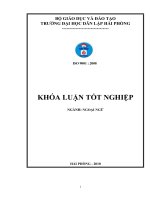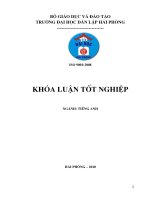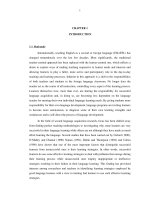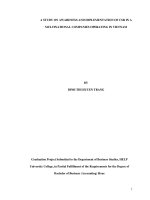A study on imperative and errors made by vietnamese learners
Bạn đang xem bản rút gọn của tài liệu. Xem và tải ngay bản đầy đủ của tài liệu tại đây (343.84 KB, 62 trang )
BỘ GIÁO DỤC VÀ ĐÀO TẠO
TRƯỜNG ĐẠI HỌC DÂN LẬP HẢI PHỊNG
-------------------------------
ISO 9001 : 2008
KHĨA LUẬN TỐT NGHIỆP
NGÀNH: NGOẠI NGỮ
HẢI PHÒNG - 2010
HAIPHONG PRIVATE UNIVESITY
FOREIGN LANGUAGES DEPARTMENT
-----------------------------------
GRADUATION PAPER
A STUDY ON IMPERATIVE AND
ERRORS MADE BY VIETNAMESE LEARNERS
By:
Đinh Thị Phương
Class:NA1001
Supervisor:
Phạm Thị Thu Hằng.M.A
HAI PHONG - 2010
BỘ GIÁO DỤC VÀ ĐÀO TẠO
TRƯỜNG ĐẠI HỌC DÂN LẬP HẢI PHÒNG
-------------------------------------(VnTimeH, 14pt, Bold)
Nhiệm vụ đề tài tốt nghiệp
(VnTimeH, 23pt, Bold)
Sinh viên: Đinh Thị Phương
Mã số: 100031
Lớp: NA1001
Ngành: Ngoại Ngữ
Tên đề tài: A study on imperative mood and some errors made by
Vietnamese learners.
Nhiệm vụ đề tài
1. Nội dung và các yêu cầu cần giải quyết trong nhiệm vụ đề tài tốt nghiệp
( về lý luận, thực tiễn, các số liệu cần tính toán và các bản vẽ).
……………………………………………………………………………..
……………………………………………………………………………..
……………………………………………………………………………..
……………………………………………………………………………..
……………………………………………………………………………..
……………………………………………………………………………..
……………………………………………………………………………..
……………………………………………………………………………..
2. Các số liệu cần thiết để thiết kế, tính tốn.
……………………………………………………………………………..
……………………………………………………………………………..
……………………………………………………………………………..
……………………………………………………………………………..
……………………………………………………………………………..
……………………………………………………………………………..
……………………………………………………………………………..
……………………………………………………………………………..
……………………………………………………………………………..
3. Địa điểm thực tập tốt nghiệp.
……………………………………………………………………………..
……………………………………………………………………………..
……………………………………………………………………………..
CÁN BỘ HƯỚNG DẪN ĐỀ TÀI
Người hướng dẫn thứ nhất:
Họ và tên: Phạm Thị Thu Hằng
Học hàm, học vị: Thạc Sỹ
Cơ quan cơng tác:Trường Đại Học Dân Lập Hải Phịng
Nội dung hướng dẫn: A study on imperative mood and some errors made by
Vietnamese learners
Người hướng dẫn thứ hai:
Họ và tên:
Học hàm, học vị:
Cơ quan công tác:
Nội dung hướng dẫn:.
Đề tài tốt nghiệp được giao ngày 12 tháng 04 năm 2010
Yêu cầu phải hoàn thành xong trước ngày 10 tháng 07 năm 2010
Đã nhận nhiệm vụ ĐTTN
Sinh viên
Đã giao nhiệm vụ ĐTTN
Người hướng dẫn
Hải Phòng, ngày tháng năm 2010
HIỆU TRƯỞNG
GS.TS.NGƯT Trần Hữu Nghị
PHẦN NHẬN XÉT TÓM TẮT CỦA CÁN BỘ HƯỚNG DẪN
1. Tinh thần thái độ của sinh viên trong quá trình làm đề tài tốt nghiệp:
……………………………………………………………………………..
……………………………………………………………………………..
……………………………………………………………………………..
……………………………………………………………………………..
……………………………………………………………………………..
……………………………………………………………………………..
……………………………………………………………………………..
……………………………………………………………………………..
2. Đánh giá chất lượng của khóa luận (so với nội dung yêu cầu đã đề ra trong
nhiệm vụ Đ.T. T.N trên các mặt lý luận, thực tiễn, tính tốn số liệu…):
……………………………………………………………………………..
……………………………………………………………………………..
……………………………………………………………………………..
……………………………………………………………………………..
……………………………………………………………………………..
……………………………………………………………………………..
……………………………………………………………………………..
……………………………………………………………………………..
……………………………………………………………………………..
3. Cho điểm của cán bộ hướng dẫn (ghi bằng cả số và chữ):
……………………………………………………………………………..
……………………………………………………………………………..
……………………………………………………………………………..
Hải Phòng, ngày ….. tháng ..… năm 2010
Cán bộ hướng dẫn
(họ tên và chữ ký)
NHẬN XÉT ĐÁNH GIÁ
CỦA NGƯỜI CHẤM PHẢN BIỆN ĐỀ TÀI TỐT NGHIỆP
1. Đánh giá chất lượng đề tài tốt nghiệp về các mặt thu thập và phân tích tài liệu,
số liệu ban đầu, giá trị lí luận và thực tiễn của đề tài.
2. Cho điểm của người chấm phản biện :
(Điểm ghi bằng số và chữ)
Ngày.......... tháng......... năm 2010
Người chấm phản biện
ACKNOWLEDGEMENT
This is my graduation paper – an honor record of four – year study process
at University. This achievement will not be finished without help from many
people.
First of all, I would like to give my thanks to all the teaching staff of Foreign
Language Division of Hai Phong Private University for their enthusiasm during the
time at the University. Especially, I wish to express a deep thank to my supervisor
– M.A Pham Thi Thu Hang who has offered me a lot of assistance and guidance in
the preparation for this study: the completion of this research paper can not come
to an end without her suggestions and comments.
My thanks also go to all my friends for their collaboration and advice
concerning this study.
Last but not least, I’m also in debt to my family who always give me a lots
support and encouragement.
This graduation paper is my sincere thanks to all of you.
Hai Phong,
Dinh Thi Phuong
TABLE OF CONTENTS
ACKNOWLEDGEMENT
PART I: INTRODUCTION .................................................................................. 8
1. Rationale.................................................................................................................. 1
2. Aims of the study.................................................................................................... 2
3. Methods of the study .............................................................................................. 2
4. Scope of the study................................................................................................... 3
5. Design of the study ................................................................................................. 3
PART II: DEVELOPMENT .................................................................................. 4
Chapter 1: An overview of English mood ........................................................... 4
1. Definition of mood ................................................................................................. 4
2. Kinds of mood........................................................................................................ 4
2.1. Indicative mood ................................................................................................... 4
2.2. Imperative mood.................................................................................................. 4
2.3. Subjunctive mood ................................................................................................ 5
Chapter 2: The theoretical background of imperative mood ........................... 5
1. Definition of Imperative mood .............................................................................. 5
2. Morphology of imperative ..................................................................................... 6
2.1 Affirmative imperative ......................................................................................... 6
2.2 Negative Imperative ............................................................................................. 7
2.3 Imperatives with “let’s” and “let”........................................................................ 8
2.3.1 The first person imperative ............................................................................... 9
2.3.2 The third person imperative ............................................................................ 10
3.Kinds of imperative sentence ................................................................................ 12
3.1 Emphatic imperative (persuasive imperative or insistent imperative) ............ 12
3.2 Passive imperative .............................................................................................. 16
3.3 Subject with imperative...................................................................................... 19
3.4 The imperative with question tags ..................................................................... 20
3.5 Special cases of imperative ................................................................................ 22
3.6 Indirect Imperative sentence .............................................................................. 23
4. Usage of imperative .............................................................................................. 23
4.1 Giving an order ................................................................................................... 23
4.2 Giving a command ............................................................................................. 24
4.3 Giving an advice ................................................................................................. 26
4.4 Giving a request .................................................................................................. 26
4.5 Giving a warning and an instruction ................................................................. 27
4.6 Giving a prohibition............................................................................................ 28
4.7 Giving an entreaty............................................................................................... 28
4.8 Giving an invitation ............................................................................................ 29
4.9 Giving a condition .............................................................................................. 29
4.10 Giving a desire .................................................................................................. 29
5. The imperative to address particular people ....................................................... 29
6. The uses of “please” and “kindly” in imperatives .............................................. 31
7. Changing a statement into an imperative sentence and vice versa .................... 32
8. Punctuations in imperatives ................................................................................. 34
9. Stress in imperative.............................................................................................. 34
Chapter 3: Some errors made by Vietnamese learners and some suggested
solutions to overcome the errors .............................................................................. 36
1. Some errors made by Vietnamese learners......................................................... 36
2. The suggested solutions to overcome the errors................................................. 39
PART III: CONCLUSION ................................................................................... 41
1. Conclusion ............................................................................................................ 41
2. Suggestion for further study................................................................................. 41
EXERCISE:............................................................................................................. 42
REFERENCE
APPENDIX
PART I: INTRODUCTION
1. Rationale
With the development of human being, a means of communication should be
set to connect people closer. English has become an international language. The
fact that in communication English language is widely spoken all around the
world draws the attention of many linguists. To become fluent in this language
now is one of the essential demands of most English learners. However, it is not
easy to achieve this because this language can sometimes cause them a lot of
trouble with its grammar, vocabulary, etc…
In English grammar, mood is a difficult category and the use of mood is
popular in normal dialogue and communication. Those encourage the researcher
to study more on mood, especially imperative mood.
Furthermore, in process of using imperative mood, learners may make
mistakes that make the recipient may misunderstand the meanings of language.
Thus, it’s necessary for learners to grasp imperative mood to use it naturally and
effectively in communication. I hope that it will be useful for those who are
studying on English grammar in mood especially imperative mood.
1
2. Aims of the study
This paper tries to deal with these following concerns:
- Providing definition of mood and imperative mood.
- Demonstrating structure and usage of imperative mood
- Analyzing some errors made by Vietnamese learners.
- Giving suggestions to solve the errors.
3. Methods of the study
The information and examples in this study are selected from many
reference books and websites relating to the topic “Imperative mood”.
Some examples are used to illustrate the given information which is
extracted from variety of websites and references. Besides, to find out common
errors in my graduation paper, I had to take a survey from Hai Phong Private
University’s students through questionnaire form.
In addition to the valuable source of books and websites, this study is also
fortunate to receive the down – to – earth advices from my supervisors from
whom I have learned the ideas and techniques that I try to pass on in this study.
Those are the ways I carried out my research paper.
2
4. Scope of the study
Due to the limitation of time, I only focus on imperative mood and some
errors that learners often make.
Due to lack of experience and knowledge, this study can not avoid making
mistakes. Therefore, your truthful comments are very useful and important.
5. Design of the study
The study consists of three main parts:
Part I – Introduction which states rationale, aims, methods, scope and
design of the study.
Part II – The main part of the study, is the Development. This part is
subdivided into three chapters:
Chapter 1 is an overview of English mood.
Chapter 2 is the theoretical background of imperative mood.
Chapter 3 is some errors made by Vietnamese learners and some suggested
solutions to overcome the errors.
Part III – the Conclusion which gives the reviews of the study and
suggestion for further study.
3
PART II: DEVELOPMENT
CHAPTER 1: AN OVERVIEW OF ENGLISH MOOD
1. Definition of mood
Mood in verbs refers to one of three attitudes that a writer or speaker has to
what is being written or spoken.
There are three kinds of mood:
Imperative mood
Subjunctive mood
Indicative mood
((http:// www.english-test.net/forum/ftopic11771.html)
2. Kinds of mood
2.1. Indicative mood
Indicative mood expresses an assertion, denial or question.
For example:
Little Rock is the capital of Arkansas.
Ortriches cannot fly.
Have you finished your homework?
2.2. Imperative mood
Imperative mood expresses command, prohibition, entreaty, advice…
For example:
Don’t smoke in this building.
Be careful!
Don’t down that puppy!
4
2.3. Subjunctive mood
Subjunctive mood expresses doubt or something contrary to fact.
-
Modern English speakers use indicative mood most of the time, resorting to
kind of “mixed subjunctive” that makes use of helping verb:
If I should see him, I will tell him.
-
Americans are more likely to say:
If I see him, I will tell him.
-
The verb “may” can be used to express a wish:
May you have many more birthdays.
May you live long and prosper.
-
The verb “were” can also indicative the use of the subjunctive:\
If I were you, I wouldn’t keep driving on those tires.
If he were governor, we’d be in better fiscal shape.
/>
CHAPTER
2:
THE
THEORETICAL
BACKGROUND
OF
IMPERATIVE MOOD
1. Definition of Imperative mood
Imperative mood is a mood that expresses an intention to influence the listener’s
behavior.
5
The imperative mood is a grammatical mood that expresses direct commands or
requests. It tells you to do something. It is used to signal a prohibition, permission
or any other kind of exhortation.
(n/wiki/imperative_mood)
According to Randolph Quick (1985): “imperative, is to offer, suggest, or
request”.
2. Morphology of imperative
2.1 Affirmative imperative
Unlike most conjugated verbs in English, verbs in the imperative mood consist of a
single word rather than a phrase of two or more words. Also unlike other English
verb form, the grammatical subject of verbs in the imperative is always the second
person singular or plural personal pronoun “you”. The imperative form of English
verbs is identical to the base form (an infinitive without “to” functioning as the
infinitive marker) of any English verb.
6
For example:
Affirmative
Infinitive
Base
To be
Be
Be
To do
Do
Do
To eat
Eat
Eat
To drink
Drink
Drink
To go
Go
Go
To sleep
Sleep
Sleep
To stay
Stay
Stay
To study
Study
Study
To wait
Wait
Wait
Imperative
The form of the imperative that is identical to the base form of the verb is
sometimes referred to as an affirmative or positive imperative.
Affirmative imperative is used to tell somebody to do something.
()
2.2 Negative Imperative
Unlike affirmative imperative, negative imperative is periphrastic. Periphrastic is a
term that means a “phrase of two or more words that perform a single grammatical
function that would otherwise be expressed by the inflection of a single word”.
Negative imperative tells someone to not do something. The negative imperative
form of English verbs is formed by the present tense form of the verb “do”
followed by the adverb “not” and then the affirmative imperative form.
For example:
7
Negative
Infinitive
Base
To be
Be
Do not Be
To do
Do
Do not Do
To eat
Eat
Do not Eat
To drink
Drink
Do not Drink
To go
Go
Do not Go
To sleep
Sleep
Do not Sleep
To stay
Stay
Do not Stay
To study
Study
Do not Study
To wait
Wait
Do not Wait
To stop
Stop
Do not stop
Imperative
The “do not” of a negative imperative is often spoken and sometimes written as
the contraction “don‟t) as in:
Don’t be silly!
Don’t sleep too late.
( />
2.3 Imperatives with “let‟s” and “let”
Imperative sentence beginning with “let” are different from other imperative
sentences. Sentences beginning with “let” express ideas such as suggestion,
proposal, request, wish, determination, desire…
For example:
Let me go
8
Let’s take him to the doctor
Let no one leave him this room (the police inspector said)
Let’s go for a walk
( />
2.3.1 The first person imperative
The English language makes the first person imperative with “let + me” or “let +
us”. We use “let‟s” including yourself in the imperative.
For example:
Let me do it for you
Let me see
Let‟s stop now
Let us have some lunch
Let‟s leave the case at the station
(Martine&Thomson:123)
Because the speaker or writer is included in the imperative, the tone of the sentence
is softened. The sound of the imperative sentence is more courteous and less
demanding. Even when the speaker or writer is aware that he or she is really not
involved in the action of the verb, this form is used to sound more like a
suggestion. Compare the following pairs of sentences:
Try to be a little quieter.
Let‟s try to be a little quieter.
9
In the two illustrated sentences above, the speaker or writer is suggesting that
someone should be a little quieter and knows that the suggestion is only directed at
the person to whom the command is given. The speaker or writer is only including
himself or herself in order to make the command sound more like a suggestion.
Other examples:
Remember to send her a birthday card
Let‟s remember to send her a birthday car
(http:// www.english-test.net/forum/ftopic11771.html)
2.3.2 The third person imperative
When the speaker or writer is not included in the imperative sentence, instead, a
direct object follows “let”. The verb that describes the action of the command then
follows the direct object.For example:
Let Jack cut the grass today (direct object = Jack)
Let me use your car for the afternoon (direct object = me)
Let the soldiers rest before the next march (direct object = the soldiers)
Let her try on your new dress (direct object = her)
In order to create a negative form of an imperative, put “let’s not” or “let
somebody/ something not” in front of the infinitive verb:
(http:// www.english-for-students.com/Passive-Voice.html)
For example:
Let’s not open the door
(Quirk, &Greenbaum, 1973:201)
10









